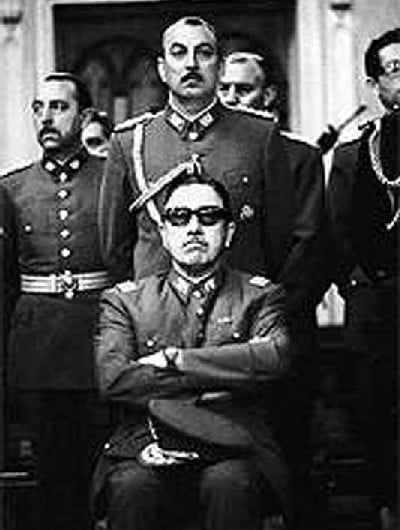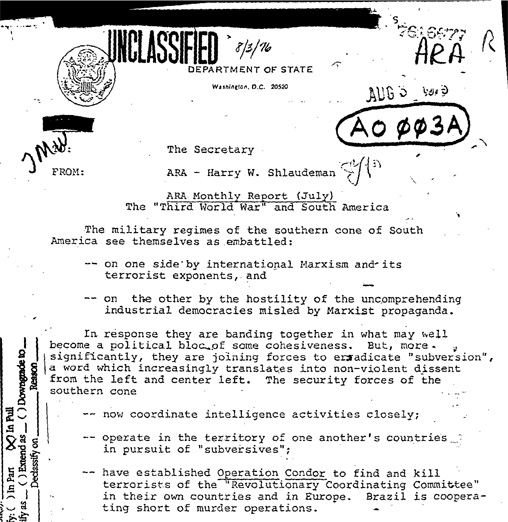Operation Condor: Trial On Latin American Rendition And Assassination Program

National Security Archive Electronic Briefing Book No. 416
Edited by Carlos Osorio
Former military officers from Argentina and Uruguay went on trial this week in Buenos Aires for their human rights abuses in Operation Condor, a cross-border conspiracy of dictatorships in the 1970s and 1980s to “eradicate ‘subversion,’ a word which increasingly translates into non-violent dissent from the left and center left,” according to declassified documents posted today by the National Security Archive ( www.nsarchive.org).
Today’s posting of documents and evidence provided by the Archive to Argentine prosecutors includes the first briefing report, from August 1976, to then-Secretary of State Henry Kissinger on the secret police collaboration in the Southern Cone to “find and kill” opponents of their military regimes.
“The documents are very useful in establishing a comprehensive analytical framework of what Operation Condor was,” said Pablo Enrique Ouvina, the lead prosecutor in the case.
Founded by the Pinochet regime in November 1975, Operation Condor was the codename for a formal Southern Cone collaboration that included transnational secret intelligence activities, kidnapping, torture, disappearance and assassination, according to the National Security Archive’s documentary evidence from U.S., Paraguayan, Argentine, and Chilean files.
Prominent victims of Condor include two former Uruguayan legislators and a former Bolivian president, Juan Torres, murdered in Buenos Aires, as well as former Chilean ambassador Orlando Letelier and his 26-year old American colleague, Ronni Moffitt, assassinated by a car bomb in downtown Washington D.C.
The historic trial charges 25 high-ranking military officials, including former Argentine presidents Jorge Videla and Reynaldo Bignone, with conspiracy to “kidnap, disappear, torture and kill” 171 opponents of the military dictatorships that dominated the Southern Cone in the 1970s and 1980s. Among the victims are approximately 80 Uruguayans, 50 Argentines, 20 Chileans and a dozen from Paraguay, Bolivia, Peru and Ecuador who were targeted by Condor operatives. The kidnapping and disappearance of two Cuban Consulate officials in Buenos Aires on August 9, 1976, is also part of the prosecution.
“Condor was a latter day rendition, torture and assassination program,” noted Carlos Osorio, who directs the Archive’s Southern Cone Documentation project. “Holding these officials accountable for the multinational crimes of Condor,” he said, “cannot help but set a precedent for more recent abuses of a similar nature.”
Besides Generals Videla and Bignone, those indicted included 22 Argentine military intelligence officers and agents. In preparation for the trial, prosecutors sought the extradition of several foreign high ranking officers from Chile and Paraguay among other Condor countries. The only foreigner sitting at the courtroom, however, is Uruguayan Army Major Manuel Cordero, charged with participating in death squads and torture at the infamous Orletti Motors secret detention center in Buenos Aires. He was extradited by Brazil where he was living.
Of the 171 Condor victims cited in the indictments, approximately forty-two survived and a number of them are expected to testify in court. One hundred twenty others were killed and/or disappeared.

THE DOCUMENTS
Document l: Department of State, Report to Kissinger, SECRET, “The Third World War and South America,” August 3, 1976.
This report, based on CIA intelligence, was written by Assistant Secretary of State for Latin America, Harry Shlaudeman and presented to Secretary of State Henry Kissinger in August 1976. The document summarizes the coordination of Southern Cone security forces:
“[T]hey are joining forces to eradicate ‘subversion,’ a word which increasingly translates into non-violent dissent from the left and center left. The security forces of the Southern Cone now coordinate intelligence activities closely; operate in the territory of one another’s countries in pursuit of ‘subversives’; have established Operation Condor to find and kill terrorists…in their own countries and in Europe. Brazil is cooperating short of murder operations.”
Document 2: Defense Intelligence Agency, [Report on Operation Condor] “Special Operations Forces,” SECRET, October 1, 1976.
This comprehensive intelligence report, based on information gathered by the FBI legal attaché in Buenos Aires, provides details on the collaboration between Argentina, Uruguay, and other Southern Cone military dictatorships. The document provided critical information to prosecutors on a joint operation with Uruguayan intelligence agents in late September 1976, in which dozens of Uruguayan members of the militant leftist movement OPR-33 were rounded up, detained, tortured, and a number killed in Buenos Aires. “The entire OPR-33 infrastructure in Argentina has been eliminated,” the document states. The kidnapped Uruguayans are among the over one hundred disappeared victims included in the Operation Condor trial. The document goes on to describe the “formation of special teams” to “carry out operations to include assassinations” in countries as far away as Portugal and France. The report cited a “favorite remark” of Southern Cone military officers as saying that “one of their colleagues is out of country because he is flying like a condor.”
Document 3: CIA, SECRET, A Brief Look at Operation Condor, August 22, 1978.
In the aftermath of the Letelier-Moffitt assassination, the CIA prepared this short briefing paper for Eugene Propper, the Justice Department’s lead prosecutor in the case. “Operation Condor is a cooperation effort by the intelligence/security services of several South American countries to combat terrorism and subversion. The original members included services from Chile, Argentina, Uruguay, Paraguay, Brazil and Bolivia; Peru and Ecuador recently became members.”
Document 4: Department of State, SECRET, “Conversation with Argentine Intelligence Source,” April 7, 1980.
In this revealing memorandum to Ambassador Castro, James J. Blystone, the Regional Security Officer (RSO) at the US Embassy in Buenos Aires, details his April 2 meeting with an Argentine intelligence source. The anonymous Argentine source describes how Horacio Campiglia and Susana Binstock, two militant Montoneros, were captured by Argentine officers of Battalion 601 (in coordination with Brazilian intelligence), taken to Argentina and held at the Campo de Mayo Army base. Campiglia and Binstock who were never seen again, are amongst the more than a hundred victims included in the Operation Condor trial.

